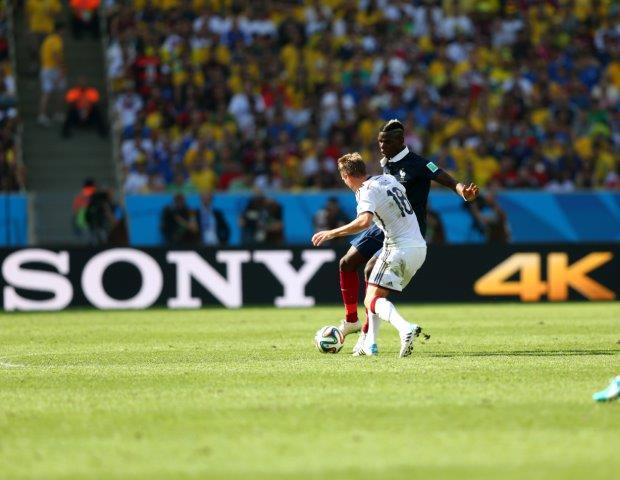Sony scores with 4K World Cup screening
July 7, 2014
By Colin Mann
 Sony – together with a range of technical partners – is claiming a new milestone in live sports entertainment with the world-first screening July 4th in 4K Ultra High Definition of the France versus Germany World Cup quarter final match at the Vue multiplex at Westfield, London. Sony and Vue Cinemas were working with technical partners Eutelsat, DSAT Cinema and International Datacasting Corporation (IDC) to deliver the coverage.
Sony – together with a range of technical partners – is claiming a new milestone in live sports entertainment with the world-first screening July 4th in 4K Ultra High Definition of the France versus Germany World Cup quarter final match at the Vue multiplex at Westfield, London. Sony and Vue Cinemas were working with technical partners Eutelsat, DSAT Cinema and International Datacasting Corporation (IDC) to deliver the coverage.
DSAT Cinema supported the screening with the commissioning and integration of the equipment, including network and receiver configuration. IDC provided the 4K UHD HEVC video decoder and professional satellite receiver installed in the cinema, receiving the 4K satellite feed and delivering the video and audio signal to the Sony theatre projector and audio system respectively. Eutelsat received the signal from Brazil at its teleport near Paris, re-encoded it in Ultra HD HEVC at 60 fps and retransmitted it to the EUTELSAT 5 West A satellite for direct distribution to the cinema. The footage was shown using Sony’s SRX-R320 4K digital cinema projection system.
David McIntosh, Vice President, Sony Digital Cinema 4K Solutions for Europe and the Americas, said that the reality of why 4K was important to the visual experience, was that it was all about the best possible visual quality. “You get that through the high resolution that 4K brings – four times high definition – but you also get it via the high contrast ratio,” he advised in a pre-match briefing with advanced-television.com.
“You get pictures that are absolutely superb quality; with the contrast ratio, you’ll see that particularly on close-up shots. For me personally, it’s almost getting to the point where it really is ‘3D without glasses’. You’re absolutely feeling immersed in the shots and you actually feel you’re in the stadium. It doesn’t apply to all the shots; some of the long shots aren’t quite as good,” he admitted.
“Sony has been talking about 4K for some time now, but the reality is that 4K is here now, be it the 4K televisions you can buy now, or your laptop, or your tablet or your home cinemas, or even the Sony Z2 mobile phone,” he advised. “This is a really leading-edge technology challenge and we have been working on it literally for three or four months.”
He noted that the transmission was not just point-to-point. “It’s simultaneously going to Liège and Arnhem, so it is a true multipoint broadcast.”
David Bush, Head of Marketing and Business Development, Sony Professional Solutions Europe, said that about 45 people working on the 4K set-up in the Estádio Jornalista Mário Filho (Maracana) stadium, completely separate from any HD production. Globosat from Brazil had provided a 4K Outside Broadcasting unit. Twelve F55 4K cameras plus one F65 4K camera super slo-mo cameras were capturing the action.
“We’re extremely proud to have got to this point; it’s the largest scale transmission yet done in 4K,” he declared.
McIntosh’s comments regarding the quality comparison of long shots proved to be accurate once match coverage commenced, not helped by the extensive shadow cast across the pitch by the towering Maracana stands. Close-up shots provided a better comparison with HD and SD, while the audio – particularly the pitch side effects microphones picking up passes, clearances, headers and shots– did help with the immersive nature of the experience.
With many an observer noting that the Host Broadcaster seems to have been concentrating on selecting crowd shots of attractive young women during breaks in the action in previous games, the 4K coverage by contrast often alighted on men with well-defined face stubble!
